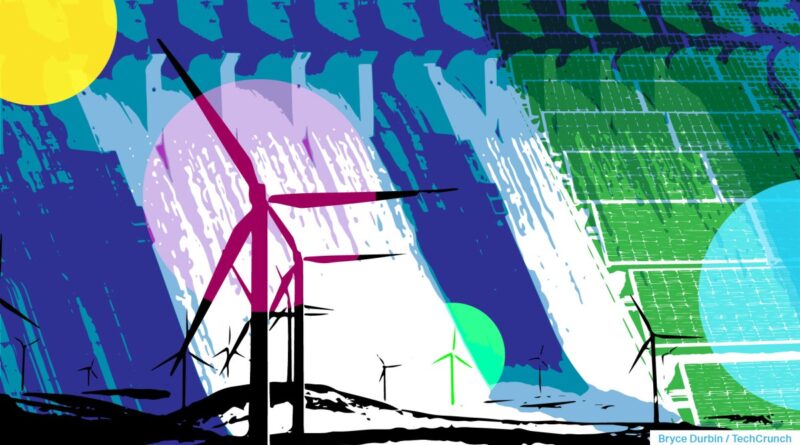For climate tech startups, the IRA is starting to pay off
The Inflation Reduction Act, signed into law by President Joe Biden in August 2022, has allocated $400 billion in federal dollars for clean energy projects as the United States aims for up to a 40% reduction in economy-wide greenhouse gas emissions by 2030. And even startups are beginning to benefit.
Private investment into climate tech startups is on track to match, and likely surpass, the government’s funding, particularly as investors feel secure in a growing market for such technologies.
In the past year, more than 270 new clean energy projects have been announced, with private investments totaling around $132 billion, according to an August report from Bank of America Global Research. Of those funds, more than half went to EVs and batteries, and the rest went to renewable energy, grid storage, carbon capture, utilization and storage and clean fuels. BoA expects these investments to create more than 86,000 jobs, including 50,000 in EVs.
Capital from the IRA will mostly flow toward established companies, but private investment, like venture capital, is finding its way to startups across all stages. Many startups have cropped up to offer auxiliary services to larger industries, and investors are taking note.
Puneeth Meruva, a partner at Trucks Venture Capital, told TechCrunch he’s seen a 10% increase in the number of climate-related startups in the year since the IRA was signed, compared to the year before. The VC clocked a 65% increase in companies related to EV charging, and a whopping 72% increase in startups tackling hydrogen technologies.
Early stage versus growth stage
“The IRA funding isn’t necessarily directly beneficial to startups because a lot of the funding is really more towards the rollout of infrastructure and products that are either well-established from a technology perspective or commoditized,” said Meruva.
That doesn’t mean startups can’t use the IRA to their advantage. The incentives in the bill are more directly applicable to startup customers. Meruva says startups can use this as a tool to sell to customers.
“If you’re selling a product related to charging, then you can go to these infrastructure developers and say, ‘Hey, there’s all this IRA funding for you to roll out chargers. Let us help you with that,’” said Meruva.
At the growth stage, the IRA has increased access to debt financing, according to Cassie Bowe, partner at Energy Impact Partners. That’s in part because the IRA includes incentives for domestic manufacturing, which makes it more likely for companies to access debt that will help finance manufacturing build-outs.
The IRA also includes project-level incentives that make it easier for companies to finance clean energy projects, said Bowe.
Startup sectors affected by the IRA
Solar
Two main tax credits in the IRA relate to solar: the Solar Investment Tax Credit (ITC) and the Advanced Manufacturing Production Credit (Section 45x). The ITC already existed, but the provision in the IRA extends the 30% tax credit to the end of 2032. Section 45X is new and it gives owners of renewable energy facilities an annual credit of $26 per megawatt-hour generated.
Bowe said portfolio companies like Ion Solar and Arcadia are leveraging the extended ITC incentive.
“It’s not only the amount of the incentive, but also the increased certainty because that incentive was extended through 2032,” said Bowe. “From an investor’s standpoint, one part of it is the amount of the incentive, but the other is just having certainty over your investment horizon.”
Over the past year, close to $40 billion of private investment capital into renewable energy (which includes solar and wind) has been announced, according to BoA.
Stationary and long duration energy storage
Energy storage is crucial for operating a grid with an increasing amount of intermittent renewables.
Before the IRA, battery energy storage had to be directly connected to renewable generators for a large chunk of the year to qualify for tax credits. Now, the IRA allows standalone energy systems, or grid-scale battery systems, to qualify, whether they are connected to renewables or not.
This, Bowe says, is huge. Especially for grid-scale storage companies like Form Energy and Powin.
“When we think about one of the biggest trends we see across the market, it’s the proliferation of batteries across all assets,” said Bowe. “So we’re playing that trend in a big way across everything from smaller mobile batteries to huge grid-scale ones.”
Energy transmission
EIP has also been making sizable investments into energy transmission, which refers to the delivery of generation electricity to the distribution grid in populated areas.
“Electricity demand is expected to double by 2040, and that’s a rate of increase that we haven’t seen basically since electricity was invented,” said Bowe. “In order to meet that demand and add all this new, clean generation that we need to have, we need to scale transmission considerably.”
The IRA also provides $5 billion in loans for constructing and modifying generation and transmission facilities. The goal is to speed up the development of transmission infrastructure, improve grid reliability and enable the sharing of surplus energy across regions.
Bowe said EIP will continue to invest in transmission, particularly because the firm’s strategic investor base includes a lot of utilities companies.
“If we don’t have enough investment in transmission, it’s possible we won’t realize up to 80% of the potential greenhouse gas emission savings that we could realize through the IRA,” said Bowe.
Hydrogen
The IRA includes a range of tax credits to support clean hydrogen fuel, biofuels and sustainable aviation fuel. This, said Meruva, was surprising given the investment community’s lackluster response to hydrogen technologies over the last decade.
While many investors are still wary of hydrogen and don’t even have an investment thesis around the fuel, Meruva says Trucks VC is bullish on hydrogen — particularly for any vehicle that’s larger than a van.
“For larger vehicles, we really can’t get away with just putting a battery in them, especially given the supply shortages we’re seeing for all materials and packs,” said Meruva. “There’s no way you can build a big enough pack for every truck in the world or for aviation, given how weight sensitive that is.”
Meruva said the big focus on batteries makes sense for passenger segments, but for commercial industries where uptime is critical, it’s time to start looking elsewhere.
“Charging just takes too long and you’re essentially asking to put a lightning bolt through a cable to make that happen fast enough,” said Meruva. “Hydrogen gives you really fast charging, in a sense. It’s almost the equivalent of battery swapping except it’s much easier because the canisters are lighter.”
The VC also noted, particularly in mining and construction, retrofitters are working to convert existing commercial vehicles into fuel-cell vehicles.
Carbon capture and sequestration
Carbon capture and sequestration (CCS) is an industry that has seen startup valuations skyrocket since the passing of the IRA, according to Bowe. That’s largely because of the huge push to decarbonize the industrial sector, which accounts for close to one-third of total U.S. emissions and is the most difficult to decarbonize.
In March 2023, the IRA launched a $6 billion Industrial Demonstrations Program that funds up to 50% of the cost of each project. This represents a $12 billion opportunity for early-stage commercial-scale projects.
That’s where startups like Carbon America can win. The developer is currently building two commercial CCS projects in Colorado, which it will own and operate, and has already received government funds.
Domestic EV manufacturing and supply chain
Domestic EV manufacturing has boomed due to the IRA’s EV tax credit and advanced manufacturing credit. Bowe said there has been $120 billion in investments announced over the last eight years in the EV supply chain, with half of those investments occurring since the IRA was passed.
Domestic battery production has seen a huge boost as the U.S. seeks to end its reliance on China. By our count, automakers and battery manufacturers have collectively invested and promised to invest close to $100 billion in building domestic cell and module manufacturing.
TechCrunch is tracking how many EV battery manufacturing facilities exist and have been promised. While the tax credits available for these mainly fall to large automakers and battery developers, there’s been plenty of room for battery innovators to succeed. Companies like 6K, Sila and Mitra Chem are making domestic battery materials. Others, like Redwood Materials, Ascend Elements and Li-Cycle, are creating battery recycling facilities on U.S. soil.
EV charging
Section 30C of the IRA offers tax credits of up to 30% per new charger installations. Yet investor insights differ when it comes to how the IRA has affected the EV charging industry. According to Bowe, the IRA is a huge catalyst, but it hasn’t fundamentally changed the sector from a year ago.
Meanwhile at the early stages, Meruva says he’s seen a lot more interest in EV charging companies. He’s also seen a drastic increase in the number of EV charging-related companies since the passage of the IRA. And many of these are focused on software.
One such startup is Stable, a Trucks VC portfolio company that developed predictive software for EV charging that covers where to install the hardware, how to forecast performance and a pricing guide.
“The types of products the market needs right now are products that work reliably and all the time,” said Bowe. “Whether it’s software or hardware models, we need EV chargers that work all the time and work with the grid. That’s what we’ve been investing in.”
Opportunities for new business sectors
Investors who spoke to TechCrunch say they’re seeing businesses sprout up to aid others in taking advantage of the new credits.
Meruva said he’s seen startups act as something akin to tax advisers to help businesses understand the complicated tax code.
Others have created a marketplace for transferable tax credits, says Bowe.
The IRA includes a transferability method of monetization for commercial and utility-scale energy projects. This allows project owners to sell tax credits to other taxpayers, which provides cash flow and project financing.
Previously, tax credits were meant to benefit energy project developers, but this left out smaller developers that didn’t pay enough in taxes to realize the credit. In the past, that credit would have simply gone to waste. Now the credit can be transferred, in exchange for financial compensation, to a company that has tax capacity.
The IRA is not overhyped
The market can often get swept away in the hype cycle, which can lead to exaggerated valuations and a misallocation of resources. Investors we spoke to say the investment provided by the IRA and as a result of the IRA is not an example of overhype.
The Congressional Budget Office forecasted the IRA would result in $400 billion in government spending, but it’s tracking to be at least three times that.
“$1.2 trillion of government spending could be viewed as a large number, but what we think about a lot is the multiples on that that will be invested by private capital managers like EIP who are deploying into this space,” said Bowe.





